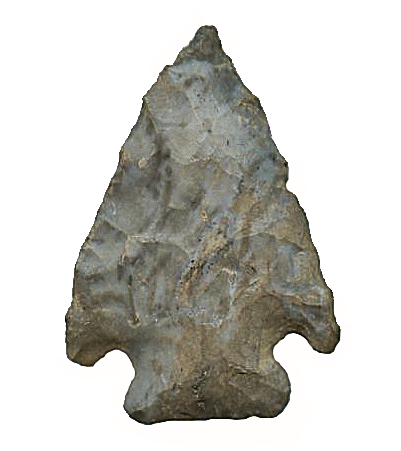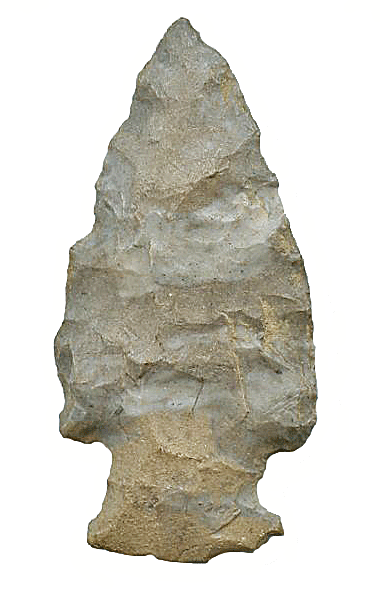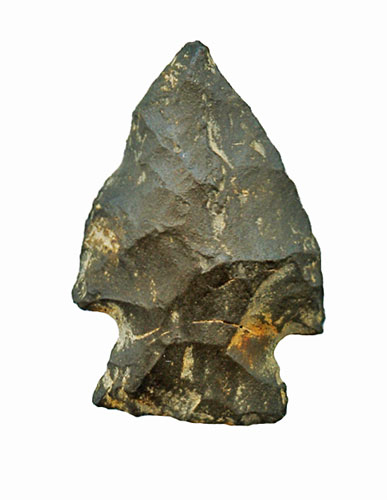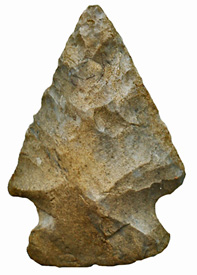







Point Type: BREWERTON
CORNER NOTCHED
Also See: Brunswick, Crooked Creek, Fishspear, Freeheley, Jacks Reef Corner Notched
, Kirk Corner Notched , Kiski, Kittatinny, Lycoming County, Matanzas,
Normanskill, Palmer ,
Snyders , Vosberg
Location: Eastern to Midwestern United States
Associated Dates:
6000 - 4000 B.P. - Middle to Late Archaic
Morphology: Corner
Notched
General Description: The
Brewerton Corner Notched is one of four types (Corner Notched, Eared
Notched, Eared Triangle, Side Notched) in the Brewerton family of points.
The Brewerton Corner Notched is a small to medium sized, relatively
thick corner notched point. The blade is
trianguloid in outline and biconvex in cross section
. The edges of the blade are slightly excurvate, less often straight and rarely incurvate
. The stem is corner notched with medium to large
corner notches forming prominent barbs, and
basally expanded
. The base is straight to slightly convex or rarely slightly
concave. About two-thirds will have their base ground smooth.
The proportions are one and one-fourth to one and one-half
times as long as wide. The larger examples are about twice as long as
wide.
The size of the Brewerton Corner Notch
ranges from 23mm to 80mm in length. The majority of points fall between 33mm and
59mm. The thickness ranges between 4.8mm and 9.6mm with the majority being
about 8mm.
The Brewerton
Corner Notched is a minority point type in the
Archaic Brewerton complex of Laurentian and the Frontenac complex of New York.
There is some evidence that the Corner Notch point type appeared later than
the Brewerton Side-Notched type. The Vosberg Point of eastern New York
differs from the Brewerton Corner Notched type in its shorter stem, smaller
notches and usually weaker barbs. The two forms do however overlap
and appear to be genetically related and are generally
contemporaneous.
The Brewerton Corner Notched is primarily found in
central and western New York and is also present in eastern New York with
occasional examples found as far south as central New Jersey and as far east as
New England. Similar points occur as a minor distribution in the Upper
Ohio Valley, Eastern Indiana and Pennsylvania.
The point is usually
made of NY Onondaga gray flint in the New York area but can be made
of local materials such as cherts, jasper and quartz. In Ohio,
the point was made from Logan County cherts (a speckled
Cedarville-Guelph flint) as well as Laurel and Harrodsburg, Indiana
cherts.
The point was named by William A. Ritchie in 1961 for
an excavation at the Robinson site in Brewerton, Oswego County, New
York. Prior to 1961, the Brewerton Corner Notched was called the
"broad corner-notched point" (Ritchie).
Perino states that the Brewerton Corner Notched point, when resharpened to
the point that the barbs are missing may be known as the Brewerton Eared
Notched Point then if continually reworked it may become the
Brewerton
Eared Triangular Point . The Vosberg
point type seem to be a variant and cannot always be separated from
the Brewerton points from a typology perspective (Perino). The Freeheley
point type of Michigan is probably a Brewerton point type which
suggests a wider and more western geographic distribution.(Hranicky).
According to DeRegnaucourt, heat treating was present on 50% of the
samples he has seen from western Ohio and eastern
Indiana.
About The
Point Above (Left shown twice size):
The beautiful and small Brewerton Corner Notched point pictured at the top of this
page, was a surface find in a corn field in Gowanda, New York. It is made from a dull dark grayish Onondaga
chert which has some darker grey to blackish mottled inclusions. It has been finely flaked and is thin for its
size. The basal area is heavily ground. The edges and point are quite sharp. Overall, the point is
highly patinated Overall, the point measures 33.5 mm in length, is 23 mm wide (at the barbs) and is 5.7 mm thick at its thickest
point. The stem measures 14.6 mm in width. Catalog Number 262-16-BB
About The Point Above (Center Left shown twice size): This
large reworked Brewerton Corner Notched point pictured at the center left top
of this page, was also a surface find in a corn field in Gowanda, New York.
It is made from a dull grayish and light greenish banded Onondaga
chert which has some mottled inclusions. It has been finely
flaked and is thin for its size. The basal area is heavily ground. The
edges and point are quite sharp however there is a dig in the tip which has
slightly reduced its length. The tip ding appears to have been reworked historically which has
reduced the barbs in
size.. Overall, the point is highly patinated with encrustation especially in the halfting area. The point
measures 46
mm in length, is 24 mm wide (at the barbs) and is 5.3 mm thick at its
thickest point. The stem measures 17 mm in width. Catalog Number
261-9-BB
About The Point Above (Center Right shown twice
size): The small Brewerton Corner
Notched point pictured at the top center right hand side of this page,
was also surface find along the Susquehanna River near the town of Berwick,
Luzerne Co. Pennsylvania. It is made from a dull black
Lehigh Valley chert. The basal area is heavily ground. The condition
of the point is very good with the exception of a small blade ding on the left
hand blade edge. Overall, the point is highly patinated with encrustation and field
dirt exists in the knapping scars. The point measures 31 mm in length,
is 20 mm wide (at the barbs) and is 7.4 mm thick at its thickest
point. The stem measures 15.4 mm in width. Catalog Number
421-10-M
About The Point Above (Right shown twice
size):
The small Brewerton Corner Notched point pictured at the top right hand side of this page,
was a surface find near Albany, New York. It appears to be made from
gray and tan Onondaga chert
. The basal area is heavily ground. The condition of the point
is very good. Overall, the point is highly patinated with encrustation and field dirt exists in the knapping
scars. The point measures 31 mm in length, is 22 mm wide (at the
barbs) and is 6.9 mm thick at its thickest point. The stem measures 17.3 mm in
width and is 8.9 mm long. Catalog Number
466-13-C
References: Boudreau, DeRegnaucourt, Dragoo (b,e), Fogleman, Hranicky, Justice(1), Overstreet, Perino (1), Ritchie
© Copyright 1997 - 2009 LITHICS-Net WWW.LITHICSNET.COM
Use your Browser's BACK Button to return to the LITHICS-Net Index.